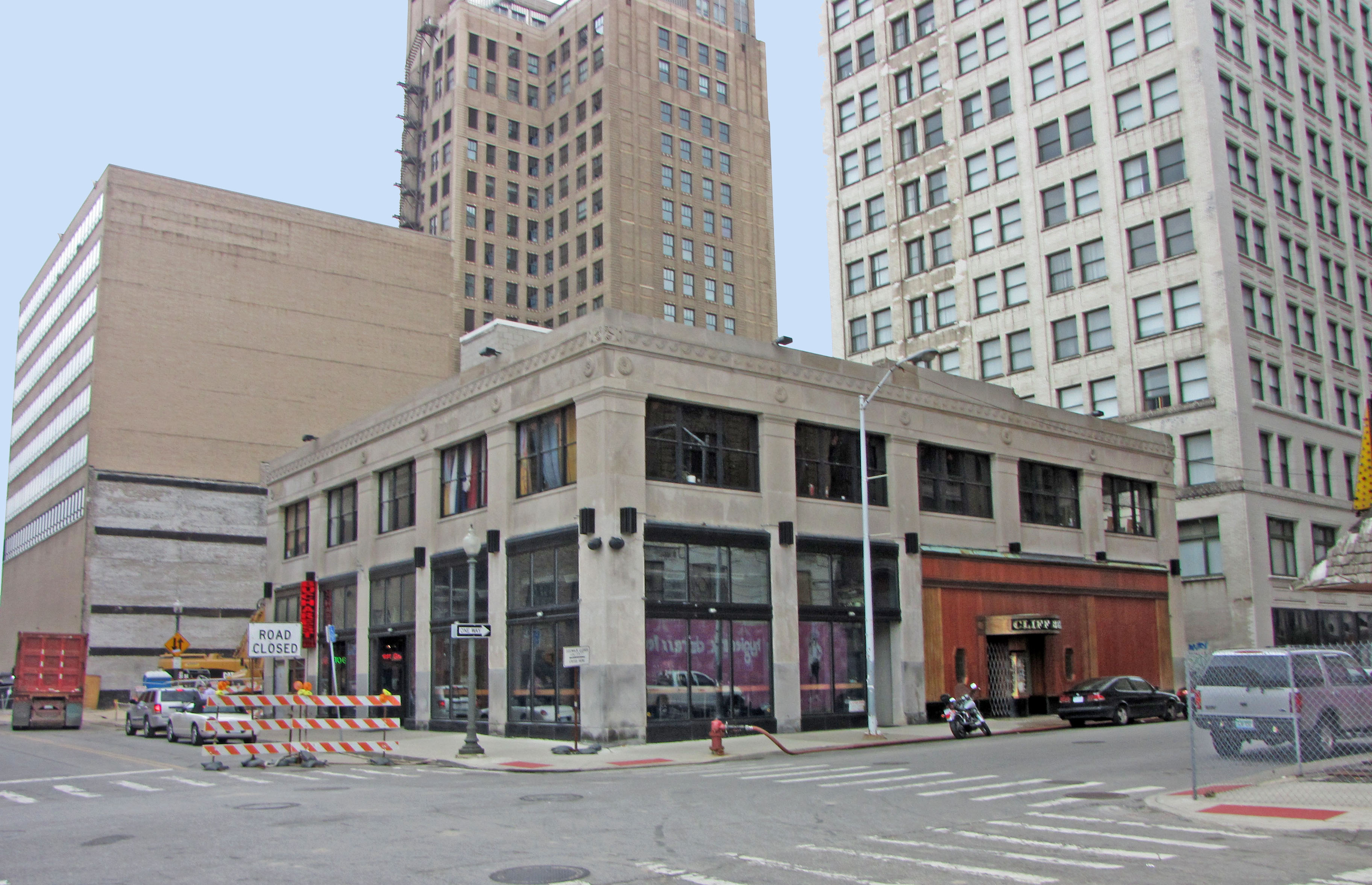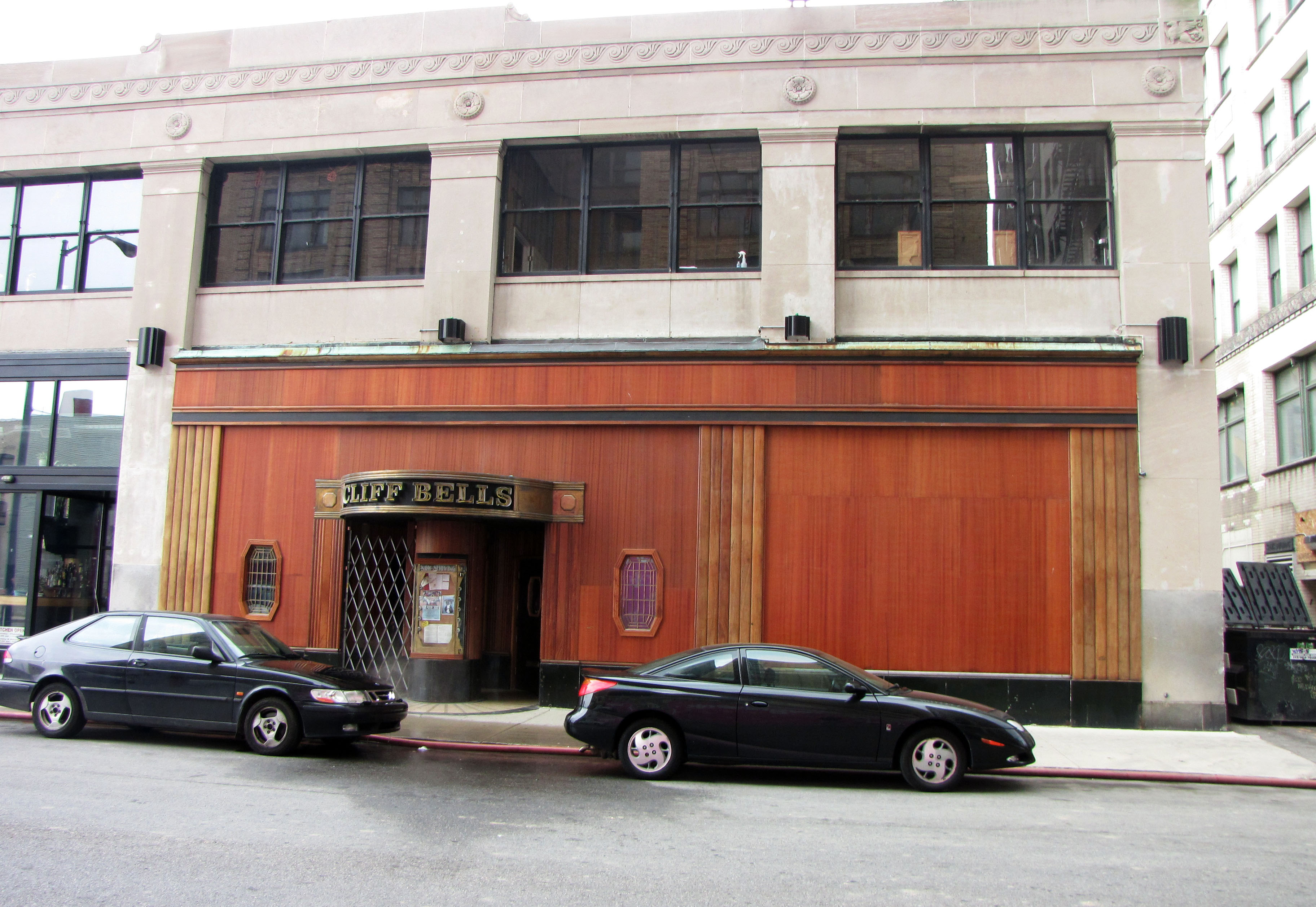

You might be surprised to find such a short building among the other tall structures lining this section of Park Avenue. Real estate developers in the 1920s encouraged the erection of the impressive buildings that would make Park Avenue one of the city’s most esteemed commercial and residential areas. Many such buildings were built and still grace the skyline—the Park Avenue Building, the Detroit Life Building, the Iodent Building, the Women’s City Club and the Royal Palm Hotel. Albert Kahn was employed to design a nine-story building on the plot of land pictured above. Before it could be completed, the stock market crashed in October, 1929 and capital was not available to finish the building. The Campau Realty firm constructed this building for their offices but, I assume, that enterprise faced the fate of many Detroit businesses in the Depression—bankruptcy and extinction.
Cultural conflicts raged at several points in the nation’s history. Perhaps they were most vibrant in the decades from 1880, when immigration from eastern and southern Europe increased, until the Depression decade. To greatly oversimplify, conservative Protestants were on one side and Catholics, Jews and liberal Protestants on the other. Or you might see it as a conflict between Americans whose ancestors arrived before 1840—many of them Anglo-Saxon Protestants—and those who arrived after famine struck northern Europe in the 1840s. Several topics were the subject of great controversy as each side sought legislation that would uphold their cultural values. One controversy was about keeping the Sabbath. Conservative Protestants succeeded in getting many municipalities to enact “Blue Laws” that closed stores and outlawed public events such as sporting events on Sundays. Many of the newer immigrants endorsed different cultural values about what was permissible on the Sabbath: picnics, public gatherings and sporting events. The Tigers played no home games in Detroit until 1909—and then did so in violation of a city ordinance—and, in Philadelphia, Blue Laws prohibited Sunday sports and closed stores until the mid-1930s.
Then there was the issue of schools. Many of the Catholic and Jewish immigrants established their own schools, often to promote religious traditions, but sometimes to preserve the language of the mother country. On the other side, many descendent of those who arrived by the Revolution argued that children should only attend public schools. They viewed parochial schools as unpatriotic. They believed that children would be assimilated only if they learned the values—including religious values—taught in the public schools. Oregon was the only state to formally outlaw non-public schools, but voters in Michigan, in the 1920s, were twice asked to pass a law mandating that all children attend public schools. Both times, they rejected such a law.
There was also the issue of immigration itself. A variety of spokespeople observed that most immigrants entering after 1880 were Catholic or Jewish by faith, and not Anglo-Saxon in ethnicity. By the first decade of the Twentieth Century, there was a large and seemingly scholarly literature arguing that these newcomers could not be assimilated and might destroy the nation’s traditional culture and political values. Some contended that Catholics owed their allegiance to a foreign potentate and that Jews favored Socialism or Communism rather than the American democracy. The Dillingham Commission in 1909 seemed to present authoritative information showing that the newcomers could perform manual labor but probably were more of a liability than an asset. Immigrants and their descendents generally favored an open door policy. The conservatives won this battle also, and Congress enacted laws in 1921 and 1924 that greatly restricted immigration from southern or eastern Europe. Asian immigration had been cut off three decades earlier.
The conservatives also won with regard to public morals. That is, they successfully prodded most states and many cities to adopt laws outlawing commercial sex
Finally, there was the issue of drink. Conservative Protestants—and others—argued that the consumption of alcohol played a major role in causing poverty, led to family disruption and was responsible for orphans. But most Catholic and Jewish immigrants shared cultures where alcohol was enjoyed frequently. The conservatives also won this cultural battle, and the nation in 1919, adopted the Eighteenth Amendment that prohibited the manufacture, sale, transportation or importation of intoxicating liquors.
This long introduction explains the name this building has borne since 1935. Cliff Bell’s father was a socialist labor organizer in Cincinnati. In the late Nineteenth Century, as Detroit’s manufacturing firms flourished, the elder Bell migrated to Detroit to organize for the Socialists. Apparently, he found that being a labor organizer in that era did not permit a man to support his family so he became a saloon keeper operating a pub on John R. His son, Cliff Bell, born in Cincinnati in 1886, followed his father’s profession and began working in his father’s establishment in 1902.
At first, it seemed that prohibition would be a terrible time for barkeepers. For the most part, that did not turn out to be the case. Those who voted for mayors and governors in the Northeast and Midwest felt that had a right to drink, so elected officials were highly motivated to overlook the Eighteenth Amendment. A candidate who claimed he cracked down on liquor during Prohibition was likely to lose in many states. Detroit is the nation’s only large city adjacent to Canada, so Detroit became the nation’s leading port of entry for Canadian liquor. Indeed, the number of drinking spots in Detroit apparently greatly increased with the onset of prohibition. Prior to the Eighteenth Amendment, the State of Michigan granted licenses, but with prohibition, anyone who had contacts with one of the hundreds of people illegally importing liquor across the Detroit River could open up a dram shop—and not pay taxes. There were many reports that enforcement officials in Detroit and elsewhere accepted gratuities to ensure the continued operation of gin mills.
Prohibition went into effect in 1919. In 1922, Cliff Bell opened the Grand Circus Chop House near the Detroit Athletic Club. The prestigious Detroit Athletic Club did not sell liquor, but its patrons could easily cross the street to Cliff Bell’s to enjoy a libation. His business thrived, but at some point, he decided it was in his interests to keep a lower profile so he surrendered operation of the Grand Circus Chop House and opened a lower profile drinking establishment, The Parisian Club, on Lothrop. By 1930, Cliff Bell was running the Erskine Bridge Club at John R and Erskine. Apparently he sold very high quality, illegal liquor from Quebec while most of his competitors sold lower quality alcohol brought in from Ontario. There is no State of Michigan Historical Marker at Erskine and John R, but Cliff Bell was, presumably, the inventor of the bar stool. For the first time in history, they were installed in his bar. Pundits of that era observed that there was never a deck of cards in the Erskine Bridge Club.
Following the election of President Roosevelt in 1932, it became increasingly clear that Congress would approve the sale of beer and that Congress and state legislatures would subsequently repeal prohibition. There was probably no federal ordinance that was more frequently and universally violated than the Constitutional ban on alcohol. In cities such as Detroit, it also generated a tremendous increase in homicides as rival gangs sought to protect their illegal but very popular and lucrative businesses. Realizing the Prohibition was about to end, Cliff Bell created a new establishment on Peterboro, the Commodore Club. Bell imported national talent to this very successful nightclub.
In the midst of the Depression—1935—Bell decided to open an especially elegant night club at the end of Prohibition. Presumably, the Campau Realty Building was vacant, so he selected that prestigious site and commissioned one of the city’s leading architects, Charles Agee, to design the business that still carries his name.
Cliff Bell operated this popular night club until his retirement in 1958. He lived another twenty years, dying in his early nineties and having prospered in both Prohibition and the Depression. With the decline of activity in downtown Detroit and the deterioration of Park Avenue, Cliff Bell’s closed in 1985. However, it is well positioned to attract those who attend events at the Fox Theater, Comerica Park and Ford Field. It reopened in 2005 and it is now one of Detroit’s premier jazz locations.
Architect for the building: Albert Kahn
Architect for the jazz club: Charles Agee
Date of construction: 1928
Date of construction of the jazz club: 1935
Use in 2009: Musical venue
Website for Cliff Bell’s: http://www.yelp.com/biz/cliff-bells-detroit
City of Detroit Designated Historic District: Not listed
State of Michigan Registry of Historical Places: Cliff Bell’s is within the Park Avenue
Historic District listed: April 18, 1996
National Register of Historic Sites: Cliff Bell’s is within the Park Avenue Historic
District listed: May 13, 1997
Photograph: Ren Farley; August 18, 2009
Description prepared: September, 2009